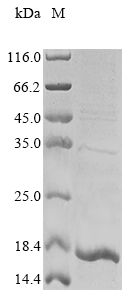Recombinant Mouse Stefin-1 (Stfa1) represents a full-length protein expressed in E.coli, spanning amino acids 1 to 97. The protein includes an N-terminal 6xHis-tag, which appears to streamline purification and detection processes. SDS-PAGE analysis confirms the product maintains purity levels above 85%, suggesting reliable performance in research settings. This research-grade product shows low endotoxin levels that may be suitable for diverse experimental conditions.
Stefin-1 functions as a cysteine protease inhibitor and seems to play an important role in controlling proteolytic activity within cells. As part of the cystatin family, it likely participates in pathways that govern protein degradation. The protein appears essential for cellular balance and often draws attention in research where tight protease control is necessary. Its significance extends across multiple research fields, particularly cell biology and enzymology.
Potential Applications
Note: The applications listed below are based on what we know about this protein's biological functions, published research, and experience from experts in the field. However, we haven't fully tested all of these applications ourselves yet. We'd recommend running some preliminary tests first to make sure they work for your specific research goals.
Mouse Stefin-1 is a cysteine protease inhibitor that requires precise folding, proper tertiary structure, and specific reactive site conformation for its functional activity in protease inhibition. The E. coli expression system may not provide the optimal eukaryotic folding environment for this mammalian protein, but Stefin-1 is a relatively small protein (97 aa) without complex post-translational modifications, increasing the probability of correct folding. The N-terminal 6xHis-tag is small and may cause minimal steric interference. While the full-length protein (1-97aa) contains all functional domains, the probability of correct folding with functional inhibitory activity requires experimental validation of protease inhibition capability.
1. Cysteine Protease Inhibition Studies
This application carries a significant risk without functional validation. Stefin-1's inhibitory activity requires precise folding and proper reactive site formation. If correctly folded and active (verified through protease inhibition assays), the protein is suitable for kinetic studies. If misfolded/inactive (unverified), inhibition measurements will yield biologically meaningless results.
2. Protein-Protein Interaction Analysis
This application requires proper folding validation. Stefin-1 interactions with proteases require native conformation. If correctly folded (verified), the protein may identify physiological interaction partners. If misfolded/unverified, there is a risk of non-specific binding or failure to replicate genuine protease-inhibitor interactions.
3. Antibody Development and Validation
This application is highly suitable as antibody development relies on antigenic sequence recognition rather than functional protein folding. The full-length protein provides comprehensive epitope coverage for generating Stefin-1-specific antibodies. The high purity (>90%) ensures minimal contamination-related issues during immunization protocols.
4. Structural and Biophysical Characterization
These studies are essential for determining folding status. Techniques should include circular dichroism spectroscopy to assess secondary structure, thermal shift assays to evaluate stability, and protease inhibition assays to validate functionality. If correctly folded, results are valuable; if misfolded, they characterize the recombinant construct.
5. Comparative Species Analysis
Meaningful comparative studies require native protein conformation and functional activity. If correctly folded and active (verified), the protein enables valid evolutionary comparisons. If misfolded/inactive (unverified), comparative analyses would yield misleading insights about stefin conservation and function.
Final Recommendation & Action Plan
The E. coli-expressed Stefin-1 with a small His-tag has a moderate to high probability of correct folding due to the protein's small size and lack of complex modifications, but experimental validation is crucial. Begin with Application 4 (Structural Characterization) to assess folding quality through CD spectroscopy and validate inhibitory activity using standard protease inhibition assays (e.g., against cathepsins). Applications 1, 2, and 5 require rigorous functional validation before proceeding. Application 3 (antibody development) can proceed immediately. For reliable Stefin-1 research, confirm inhibitory activity and consider using refolding protocols if initial validation indicates poor functionality.






